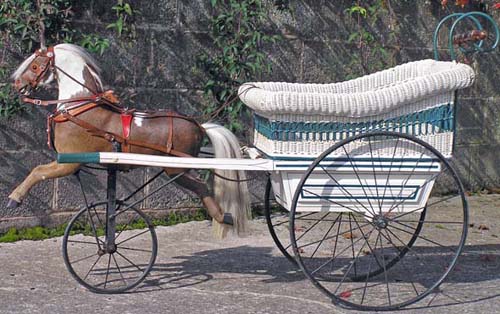
This site is related to my main website ( which is about my old rocking horses - info, for sale
and wanted. Click for a link to www.oldrockinghorses.com
).
Here are some pages of information on types of old rocking horse which I hope will help you to
identify your own horse or to give you some idea of what is available when buying an antique
or old rocking horse. Also there are some pictures of modern reproductions,
not to be confused with old rocking horses. I hope to add something on one or two more makers
soon and if anyone would like to contribute to this site please email.
Identification of old rocking horses is easy for some types, hard for others and impossible
for many horses. The pages here are mainly about the well-documented makers: F H Ayres,
Lines / Triang * and the Collinson family. There is also some information on a handful
of less well-recognized makers and reproductions of antiques (fakes).
Toy horses have been made in various forms for perhaps 3000 years. Rocking horses as we know them
date from about 1750 for bow rockers and from around 1880 for horses on swing stands.
Bow rockers are still made but they became less popular after the introduction of the swing or
safety stand: they take up a lot of space and can run over toes which is painful. Rocking horses were
made in hundreds of thousands from about 1870 to 1920. There were hundreds of
makers but sadly few were documented and so little is known about them. This is why it can be so
difficult to identify an old horse because most have no labels or logos. They were entirely hand made
and as these mostly small businesses developed and changed their products, variations appeared
in the house style - making it even harder to put a name to some horses.
Rockers declined in popularity almost in
parallel with the decline of horse drawn transport and few were made after
1940. Now both antique and new rocking horses are again in demand and there is
a good choice of horse available.
Note this site does not have pages on the many excellent modern British rocking horse makers.
These
people are creating quality horses which will in future be valued antiques. Their horses are not
to be confused with the fake antiques now flooding the market.
For old English rocking horses, beauty, skill of the
carving and of the finish are what makes a horse desirable. Good English rocking horses
have elegance and although they are certainly stylized, they retain the essential features,
expression and movement of a real horse. The leg joints should look as if they would work,
rather than being at impossible angles. The hoof - fetlock area is particularly important
if a horse is to look as if it actually could gallop.
Last but most importantly, the identifications I have attached to my horses are my best attempts,
and please do let me know if I have got anything wrong. I am always learning and
it is by talking to others and looking at more horses that I will be able to give
more information on this site.
I hope you don't
mind the names on the horses, it is by far the easiest way of cataloguing them.

* Note the name Tri-ang is now in use again but the new company and its horses are not the Lines companies discussed here.
NB For reference books on the subject, look at the books for sale section in my main website ( link in the contents bar ).
Copyright to all text and pictures on www.oldrockinghorses.co.uk ( except where acknowledgement is given to others )
belongs to Jane Hooker.

email jane@oldrockinghorses.co.uk
Telephone +44 (0)1749 880974 (Shepton Mallet, Somerset, UK)
Click the contents link below to access the rest of this site if the contents panel is not shown
on the left of the screen
CONTENTS